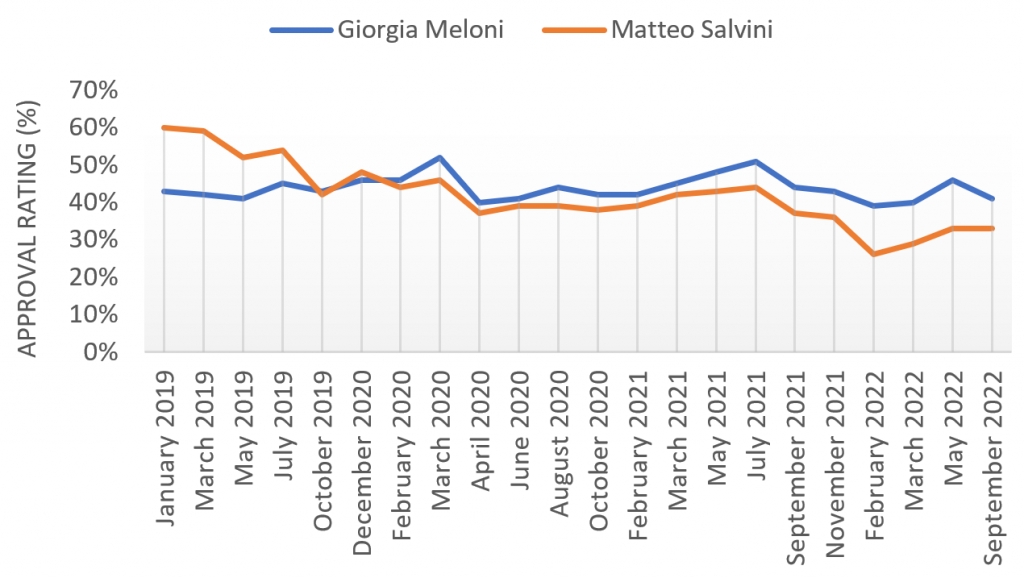Fratelli d’Italia emerged as the clear winner from Italy’s general election, but what explains the party’s success? Giovanni de Ghantuz Cubbe highlights the key factors that led to the result.
Fratelli d’Italia’s victory in the 2022 Italian general election was
long predicted, however the key factors that produced the result remain
uncertain. Although comprehensive statistical data and precise analyses
of voting determinants are not yet available, a number of potential
explanations can nevertheless be put forward.
First, the fact that Fratelli d’Italia was the only one of Italy’s
main parties to remain in the opposition group during Mario Draghi’s
government undoubtedly played a role in its success. This allowed the
party to present itself as the only viable alternative, even at the
expense of its ally, the League (Lega).
The League’s leader, Matteo Salvini, claimed as much at the end of
the campaign, noting that Fratelli d’Italia had better ‘starting
conditions’ compared to his own party, which as a government partner was
‘forced’ to cooperate and compromise with other political players. This
was admittedly something of a convenient line for Salvini as it offered
a ready-made excuse for his party’s declining support.
Second, the success of Fratelli d’Italia can be attributed to the
popularity of its leader, Giorgia Meloni, who has been upstaging Salvini
since the end of 2019. Figure 1 below illustrates this trend, which
only became more pronounced during the leadup to the election. A few
days before the election, 41% of Italians gave a positive rating to
Meloni, while only 33% approved of Salvini.
Figure 1: Approval ratings for Giorgia Meloni and Matteo Salvini

Note: Compiled by the author using data from Demos & Pi.
Third, it is possible that Fratelli d’Italia successfully convinced
parts of the Italian electorate that it has the capacity to get Italy’s
economy back on track and that it can address the concerns of families
and firms who are currently at risk from the energy crisis.
Using rhetoric that is typical of the League, Meloni presented herself as a defender of the less well-off. It is significant that just a few days before the election, some 93% of the party’s voters listed “the strengthening of financial support for families in difficulty” as a priority the new government should pursue (all other options in this poll fell under 90%).
One can also assume there is a link between the success of Fratelli
d’Italia and the anti-immigration attitudes of a share of Italian
voters. An example concerns the arrivals of immigrants and
asylum-seekers via the Mediterranean route: in August this
year, 53% of Italians agreed with turning back rescue boats at the
border, while 46% wanted to take them in. Fratelli d’Italia and Lega
voters were overrepresented in the former group. However, the role of
the immigration issue, in contrast to 2018, should not be exaggerated. A
few weeks before the election, only 5% of Italians mentioned immigration as one of the two most important challenges facing the country.
Finally, Fratelli d’Italia’s victory can be situated within a broader
populist resurgence in Italy over the last decade, which is linked to
long-term-causes. The rising importance of Italy’s ‘many populisms’ in
2013 (Five Star Movement), 2018 (the League) and 2022 (Fratelli
d’Italia) is closely related to four factors: the weakness of Italy’s
traditional parties; their ‘resignation’
in favour of technical (Mario Monti in 2011) and semi-technical
governments (Mario Draghi in 2021); the general instability of the party
system; and the ‘endless transition’ that it has experienced since the 1990s...
more at LSE
© LSE
Key

Hover over the blue highlighted
text to view the acronym meaning

Hover
over these icons for more information

Comments:
No Comments for this Article